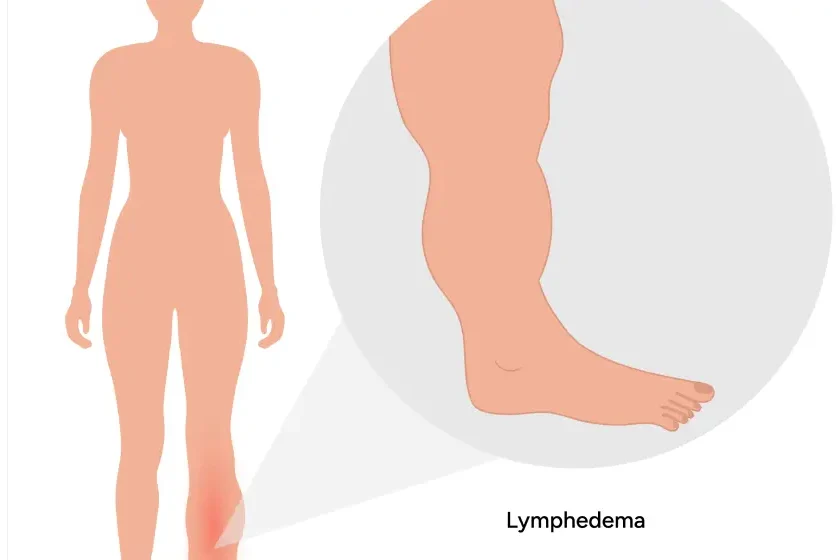
Lymphoedema – symptoms, treatments and causes
Many patients come to me with a complaint that sounds simple on the surface — “Doctor, my body is swollen.” What they describe is often more than just temporary puffiness. It is something deeper.
It may be lymphedema, a condition that affects thousands across India, yet remains underdiagnosed and misunderstood.
Let me guide you through this complex yet manageable condition, its causes, symptoms, and treatment options.
What is Lymphedema
Lymphedema is a condition in which fluid builds up in the soft tissues of your body because the lymphatic system is either blocked or damaged. The lymphatic system is a network of vessels and nodes that helps drain excess fluid from tissues and fight infections. When this system stops working properly, swelling occurs, most commonly in the arms or legs, but in severe cases, the swelling may involve the entire body.
This condition is not just a cosmetic issue. If left untreated, it can cause pain, skin infections, hardening of the skin, and reduced mobility. In rare cases, it can also lead to lymphatic cancer.
Causes of Lymphedema
Primary vs Secondary Lymphedema
Lymphedema is divided into two types. Primary lymphedema is caused by a genetic problem that affects the development of the lymphatic system. It is rare and may show symptoms at birth or during puberty.
Secondary lymphedema is more common and occurs due to damage to the lymphatic system. It can happen due to surgery, infection, cancer, radiation therapy, or trauma. In India, one of the major causes of secondary lymphedema is filariasis, a parasitic infection spread by mosquitoes. This condition is still prevalent in many states like Bihar, Uttar Pradesh, Odisha, and Tamil Nadu.
Common Causes of Full Body Edema
While lymphedema often affects one limb or region, full-body edema can occur in severe cases or due to systemic issues such as heart failure, kidney disease, liver cirrhosis, or low protein levels in the blood. When I evaluate a patient with full-body swelling, I always begin by ruling out these major medical conditions before confirming lymphatic dysfunction.
How Damage to the Lymphatic System Leads to Swelling
Your lymphatic system works silently every day, filtering out waste and maintaining fluid balance. When the flow gets blocked or the nodes are damaged, fluid builds up in tissues, especially under the skin. This causes persistent swelling and thickening of the affected area.
Symptoms of Lymphedema
Early Warning Signs and Progression
In its early stage, lymphedema presents as mild swelling that comes and goes. Many people ignore it, thinking it is due to fatigue or weather changes. As the condition progresses, the swelling becomes constant and may be accompanied by a feeling of heaviness, tight skin, decreased flexibility, or hardening of the skin.
Recognizing Symptoms of Lymphedema in Different Body Parts
Most patients notice swelling in one leg or arm, but it can also affect the chest, abdomen, face, or genitals. In cases of full-body edema, the swelling may appear more generalized, which can confuse both patients and doctors. Close attention to symptoms like skin tightness, discomfort in clothing, and recurring infections can help catch lymphedema early.
When to Seek Medical Help
If your swelling does not improve with rest or elevating the limb, or if it is accompanied by redness, warmth, pain, or fever, you should consult a specialist immediately. As a vascular surgeon in India, I often see patients at advanced stages who could have had better outcomes with earlier intervention.
Swollen Body Treatment Options
Lifestyle Changes and Self-Care Techniques
Treatment for lymphedema begins with lifestyle management. I always recommend:
- Regular exercise to stimulate lymph flow
- Elevating the affected limb whenever possible
- Wearing loose clothing
- Keeping skin clean and moisturized to prevent infections
Weight management and quitting smoking can also improve outcomes significantly.
Medical Therapies and Advanced Treatments
Lymphedema cannot be completely cured, but it can be effectively managed. I use a combination of treatments such as:
- Manual lymphatic drainage, a special type of massage that moves fluid out of the affected area
- Compression therapy using custom-fit garments or bandages
- Diuretics are generally not effective for lymphedema, unlike in other causes of swelling
Role of Compression Therapy and Lymphatic Drainage
Compression garments are a key part of treatment. They apply pressure to help move fluid out of the swollen area and prevent it from returning. Lymphatic drainage therapy, when done by trained professionals, can improve symptoms and reduce the risk of infection.
Lymphedema Treatment Approaches
Surgical and Non-Surgical Interventions
For patients who do not respond to conservative treatment, surgical options are available. These include procedures to remove fibrotic tissue or create new lymphatic channels using advanced microsurgery techniques. As one of the few vascular surgeons in India trained in these methods, I carefully evaluate each patient’s case before suggesting surgery.
How Modern Medical Advancements Help Manage Lymphedema
With the help of newer technologies like ICG lymphography and lymphatic mapping, we can now pinpoint blockages and monitor lymph flow more accurately. This helps in creating personalized treatment plans that deliver better results.
Best Practices for Long-Term Management
Lymphedema is a lifelong condition. Regular follow-ups, proper hygiene, wearing compression garments daily, and avoiding injuries to the affected limb are all part of managing it successfully. Support groups and counselling also play a big role in helping patients cope emotionally.
Why Choose Dr. Sumit Kapadia for Lymphedema Treatment
As a vascular and endovascular surgeon, I have managed hundreds of patients with mild to severe lymphedema. My approach combines thorough diagnosis, evidence-based treatments, and continuous support. I also work closely with a team of physiotherapists and skin specialists to ensure a comprehensive care plan.
Many of my patients, especially those who have suffered for years without a diagnosis, find relief and improved quality of life after a few months of structured treatment. Every patient receives a customized plan based on their stage, symptoms, and lifestyle needs.
Conclusion
Lymphedema is not just a swelling problem. It is a chronic condition that demands early recognition and proactive treatment. Whether it affects one part of your body or causes full-body edema, timely medical intervention can prevent complications and restore quality of life.
If you or someone you know is experiencing unexplained swelling that refuses to go away, consult a vascular specialist. Early care can prevent lifelong discomfort.
Frequently Asked Questions (FAQs)
Lymphedema is caused by blockages or damage to the lymphatic system due to congenital issues, surgery, infections, cancer, or trauma
Lymphedema cannot be cured completely but it can be effectively managed with therapy, lifestyle changes, and in some cases surgery
It can feel like heaviness, tightness, or dull aching in the affected area, especially after standing for long periods
A doctor may use physical examination, limb measurements, lymphoscintigraphy, or newer imaging methods like ICG lymphography
This is the advanced stage where the limb becomes severely swollen, hard, and prone to infections and ulcers

Dr. Sumit Kapadia
MBBS, MS, MRCS, DNB-Fellow



